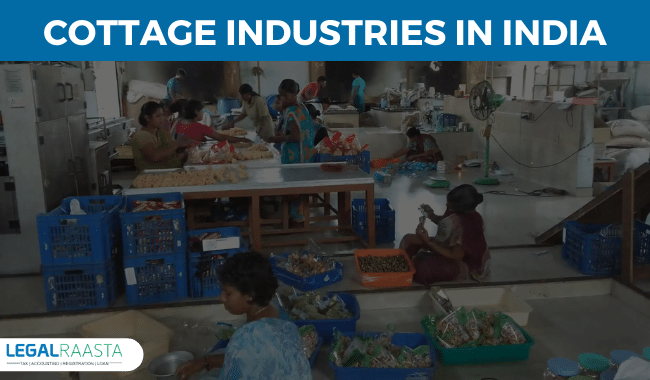When goods are manufactured on a small scale, the term “cottage industry” is used. The enormous number of ancient cottage enterprises in India is well known. Cottage industries, on the other hand, saw a severe fall with the introduction of industrialisation. The government, on the other hand, has taken steps to revitalise cottage industries, and they now play an important role in the country’s economy. Cotton weaving, silk weaving, carpet making, leather industry, metal handicrafts, and small food processing businesses are the top five Indian cottage industries. In India, cotton weaving is a significant cottage industry.
Cotton clothing is frequently worn throughout the country, therefore this expertise extends back to ancient times. Cotton weaving in India is noted for its traditional motifs and patterns created by skilled weavers using looms. Maharashtra, Tamil Nadu, and Gujarat are the cotton-producing states in India. Another well-known cottage industry in India is silk weaving. Silk is worn on important occasions such as weddings and festivals, and India is one of the largest manufacturers and consumers of the material. India’s silk varieties include Mulberry, Muga, Tassore, and Eri. Karnataka accounts for approximately 70% of India’s silk weaving industry.
During the Mughal dynasty, carpet making was brought to India. India is also famed for its durries and coir mats, despite the fact that Kashmiri carpets are world-renowned for their exquisite quality. Kashmir, Rajasthan, Punjab, Uttar Pradesh, Andhra Pradesh, and Punjab are all home to the carpet industry in India. The Carpet Export Promotion Council was established by the Indian government to promote handknitted rugs and various types and styles of floor coverings from around the country. India is a major exporter of high-quality leather to other countries.
The Indian tanning business can meet around 10% of worldwide demand. This industry employs over 2.5 million people and is one of India’s biggest export earners. Tamil Nadu, West Bengal, and Uttar Pradesh are the three biggest leather-producing states in India. In India, metal has traditionally been utilised to create figurines, utensils, and jewellery. Metal handicrafts have a distinct Indian flavour to them and are well-liked all over the world. They have made a substantial contribution to India’s economy. The cottage industry is a concentrated form of small-scale business in which commodities are produced in the homes of the employees and the workforce consists of family members.
The cottage industry is characterised by its lack of organisation and belongs into the category of small-scale industry. They use traditional processes to manufacture consumable products. These kinds of businesses start in rural areas where unemployment and underemployment are common. Cottage industries benefit the economy by absorbing a large portion of the surviving workers in rural areas. The cottage Industry, on the other hand, cannot be regarded a mass manufacturer of goods. Medium and big industries, which necessitate large capital investments for all types of high-end technologies, pose a significant threat.
OPPORTUNITIES IN INDIA’S COTTAGE INDUSTRIES
Contents
The cottage industry is frequently defined by its huge potential for job creation, and the individual hired is essentially considered self-employed. The cottage industry has been scientifically proven to provide economic independence to women in both developing and industrialised countries. Cottage industries entail the participation of all family members in the family’s development. The most typical type of government support for this industry is the provision of capital subsidies. Self-help groups are another option. In India, cottage and small-scale enterprises account for roughly 40% of total industrial output. In the state of West Bengal, there are roughly 3,50,000 units, employing over 2.2 million people.
Therefore, this industry has brought economic freedom to women in both developing and developed countries, according to empirical evidence. Furthermore, because the entire family is involved in the production of things in this industry, it provides year-round work to a large number of households.
Types of Indian Cottage Industry
The phrase “cottage industry” refers to manufacturing businesses that do most of their work by hand. India is recognised and known for its diversified culture, handicrafts from traditional cottage industries, and a wide range of cuisine items, among other things. Cotton weaving, carpet weaving, silk weaving, leather industry, metal handicrafts, and minor food processing are the principal cottage industries in India.
- Cotton Weaving: In India, cotton weaving is a very important cottage industry. Cotton clothing is commonly worn across the country, therefore the expertise dates back to ancient times. Cotton clothing is noted for its classic design, rich colour, and patterns created by skilled weavers using handlooms. Maharashtra, Tamil Nadu, and Gujarat are the three states with the most cotton production.
- Sikh weaving: Silk weaving is another well-known cottage industry in India. Silk is a key producer and exporter in our country, both domestically and internationally. Karnataka is the most important silk producer, accounting for almost 70% of the total silk weaving industry. Within our count, Mulberry, Tassore, Muga, and Eri silks are produced.
- Carpet Weaving: Carpet-weaving was first introduced to India during the Mughal period. The Kashmiri carpet is famed for its outstanding quality and texture, but so are the durries and coir carpets. The carpet business is spread out over the country, with the majority of it concentrated in Kashmir, Rajasthan, Punjab, Uttar Pradesh, Andhra Pradesh, and Punjab. In addition, the Indian government has established the Carpet Export Council to promote knotted rugs and other forms of floor coverings from all around the country.
- Leather production: India is a major producer of high-quality leather to worldwide markets, meeting roughly 10% of global demand. The leather sector employs approximately 2.5 million people and is one of India’s largest export earners. Tamil Nadu, West Bengal, and Uttar Pradesh are the Indian states that produce leather.
- Metal Works: In India, metal has traditionally been utilised to create figurines, jewellery, utensils, and other items. India’s metal handicrafts are well-liked around the world and contribute significantly to the country’s economy. Metal handicrafts are made without the use of high-tech equipment and are made with hand-operated tools.
PROBLEMS FACED BY COTTAGE INDUSTRIES IN INDIA
The cottage sector is valued for its huge potential for job creation. However, while employment in this business has increased over time, people’s income has declined as middlemen provide low rates to the makers while taking large portions of money from the purchasers. But it isn’t just the middlemen and dealers who are to blame. The current state of the cottage industry is also due to the altered foreign policies and globalisation. Power looms are always posing a threat to handloom weavers. These employees have dedicated their entire lives to knitting and needlework.
They have an unmatched level of expertise. However, they are still in the same area where they began years ago. An industry that employs a substantial portion of our population is in such bad shape. With almost 4 million individuals employed in the handloom sector, this situation demonstrates the hardships that these people face. It’s worth noting that nearly half of the people employed in this profession live in poverty. In addition, according to the 2017 census, these people’s average yearly household income is barely Rs 41,068. And, given the enormous family sizes in this segment of the population, the per capita income is hardly enough to live on.
In India, cottage industries face a scarcity of capital and a great supply of labour, forcing them to invest in capital-saving measures. As a result, there is a pressing need to employ strategies that not only increase output but also expand labourers’ abilities and suit the needs of the local market. Efforts should be put toward the advancement of technology so that workers can live comfortably. The government could also offer subsidiaries to help cottage industries flourish, particularly in their early stages. Cottage industry labourers frequently find themselves up against the odds at every stage of their operation, whether it’s purchasing raw materials or marketing their wares, securing money or obtaining insurance coverage, and so on.
- The Raw-Materials Issue
The owners of these businesses cannot afford to buy raw materials in bulk due to their restricted resources. That is why they pay a lot of money for low-quality materials.
- Financial Issues
These industries do not have access to low-cost, easy-to-get financing. The government’s and banks’ funding systems are set up in such a way that these businesses must fulfil several formalities and deal with numerous obstacles.
- Issues with marketing
These enterprises are primarily found in villages, and their ability to locate adequate markets for their products is hampered by a lack of transportation and communication services.
- A Managerial Deficit Talent
Cottage and small-scale enterprises are typically conducted by tiny business owners who lack managerial and organisational skills. How can these sectors compete with the huge seals industries, which are managed and structured by experts in the field?
- Rivalry with large-scale businesses
The fundamental issue these industries face is their inability to compete with large-scale businesses. Because they lack access to the economies of large-scale production, they are unable to compete with large-scale industries. When it comes to capturing the attention of contemporary industry, cottage industries are the losers. This necessitates the protection and promotion of cottage industries through the development of state policies aimed at enhancing the industry’s profitability and technological features. It is past time for the government to take some action.
GOVERNMENT ACTIONS TO RESOLVE THE PROBLEM
Because of the importance of the cottage and small seals industries, the government has taken numerous initiatives to address their issues. The following are the primary steps taken:
- The Union Government has established a variety of agencies to assist small businesses and villages. The Khadi and Village Industries Commission, the All India Handicrafts Board, the AH India-Handloom Board, and the Central Silk Board are among them.
- These industries have access to credit through a variety of institutions. The small-scale sector is a priority sector for the provision of institutional credit.
- Industrial estates and rural industrial projects have been established, as well as industrial co-operatives.
- The Central Government has set out 807 goods for exclusive manufacture in the small-scale sector in order to stimulate it.
- At the district level, District Industries Centres are being developed to provide all of the services and support that small and village enterprises require under one roof.
- For the development of cottage and small-scale enterprises, the Industrial Policy Resolution of 1980 contains the following provisions:
(a) Introducing a program for building up buffer stockpiles of basic commodities that are often difficult to obtain. Special requirements of states that rely substantially on a few key raw commodities will be prioritised.
(b) The government will establish a few nucleus plants in each district to generate as many ancillaries and small and cottage suits as possible. The output of the ancillary and small-scale units falling inside its orbit would be assembled by a nucleus plant.
c) Raising the capital investment ceiling for small and auxiliary businesses.
ORGANIZATIONS WORKING IN INDIA FOR THE BENEFIT OF THE COTTAGE INDUSTRY
Cottage industries in India are being developed and endorsed by well-known organisations such as the Khadi and Village Industries Commission (KVIC). Other notable organisations include the Central Silk Board, the Coir Board, the All India Handloom Board, and the All India Handicrafts Board, as well as Forest Corporations and the National Small Industries Corporation, which are all working to expand cottage industries in India.
The Department of Industries and Commerce also administers a number of programmes to aid existing and new industries with financial assistance, technical support, and direction. These projects are implemented with a focus on industry development and modernization, technological advancement, and quality control. It is run by a network of District Industries Centers (DICs), one in each district, with a General Manager in charge.
CONCLUSION
India’s cottage industries are culturally and economically significant. They preserve ancient traditions while simultaneously employing a large number of people. Because these industries confront intense competition from other economies, society should provide support to prevent exploitation and further develop them. The only solution to combat the monster of unemployment in over-populated countries like ours is to promote cottage and small-scale industries.
Cottage industries are unorganised and fall under the category of small scale industries. They use traditional ways to create consumable goods. Furthermore, these industries emerge in areas where unemployment and underemployment are common. As a result of this technique, the cottage industry benefits the economy by absorbing a large portion of the surviving workers in rural areas.
On the other hand, the industry faces numerous challenges in a variety of ways. As a result, the government is attempting to address the sector’s issues since it recognises that the sector has a lot of promise in a variety of sectors if properly supported.
Related Posts
SIDBI – Small Industries Development Bank of India & its Functions






